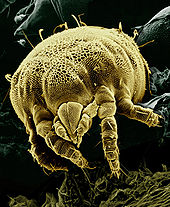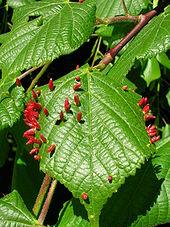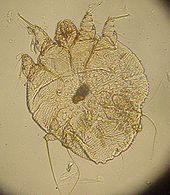- Mite
-
Mites, along with ticks, are small arthropods belonging to the subclass Acari (also known as Acarina) and the class Arachnida. The scientific discipline devoted to the study of ticks and mites is called acarology.
Contents
Diversity and systematics
All members of the subclass Acari are mites, except for the three families of ticks. Mites are among the most diverse and successful of all the invertebrate groups. They have exploited an incredible array of habitats, and because of their small size (most are microscopic) go largely unnoticed. Many live freely in the soil or water, but there are also a large number of species that live as parasites on plants, animals, and some that feed on mold. It is estimated that 48,200 species of mites have been described.[1]
Some of the plant pests include the so-called spider mites (family Tetranychidae), thread-footed mites (family Tarsonemidae), and the gall mites (family Eriophyidae). Among the species that attack animals are members of the sarcoptic mange mites (family Sarcoptidae), which burrow under the skin. Demodex mites (family Demodicidae) are parasites that live in or near the hair follicles of mammals, including humans. Perhaps the best-known mite, though, is the house dust mite (family Pyroglyphidae).
Insects may also have parasitic mites. Examples are Varroa destructor, which attaches to the body of the honeybee, and Acarapis woodi (family Tarsonemidae), which lives in the tracheae of honey bees. There are hundreds of species of mites associated with other bee species, and most are poorly described and understood. Some are thought to be parasites, while others beneficial symbionts.
The tropical species Archegozetes longisetosus is one of the strongest animals in the world, relative to its mass (100 μg): It lifts up to 1182 times its own weight, over five times more than would be expected of such a minute animal.[2]
Medical significance
Mites cause several forms of allergic diseases, including hay fever, asthma and eczema and are known to aggravate atopic dermatitis.[3] Mites are usually found in warm and humid locations, including beds. It is thought that inhalation of mites during sleep exposes the human body to some antigens that eventually induce hypersensitivity reaction.[4] Dust mite allergens are thought to be among the heaviest dust allergens.[5]
Like most of the other types of allergy, treatment of mite allergy starts with avoidance. There is a strong body of evidence showing that avoidance should be helpful in patients with atopic dermatitis triggered by exposure to mites.[6] Regular washing of mattresses and blankets with hot water can help in this regard.[7] Antihistamines are also useful; Cetirizine, for example, is shown to reduce allergic symptoms of patients.[8]
However, not all types of mites are infectious such as Alaskozetes antarcticus, an Arctic mite.[6] They only "Harvest" on Animals. Not Infectious to Humans.
See also
- Grain itch
- Copra itch
- Gamasoidosis
- Chigger bite
References
- ^ R. B. Halliday, B. M. OConnor & A. S. Baker (2000). "Global Diversity of Mites". In Peter H. Raven & Tania Williams. Nature and human society: the quest for a sustainable world : proceedings of the 1997 Forum on Biodiversity. National Academies. pp. 192–212. http://books.google.com/books?id=nDgrAAAAYAAJ&pg=PA192.
- ^ Michael Heethoff & Lars Koerner (2007). "Small but powerful – the oribatid mite Archegozetes longisetosus Aoki (Acari, Oribatida) produces disproportionate high forces". Journal of Experimental Biology 210 (17): 3036–3042. doi:10.1242/jeb.008276. PMID 17704078.
- ^ Paul Klenerman, Brian Lipworth. "House dust mite allergy". NetDoctor. http://www.netdoctor.co.uk/health_advice/facts/allergyhousedustmite.htm. Retrieved February 20, 2008.
- ^ "Hypersensitivity reaction to mite allergens". Allergy Guide. http://www.alergy.org.uk/mite-alergy.html. Retrieved February 20, 2008.
- ^ "Dust allergens". AllergyEscape.com. http://www.allergyescape.com/dust-mites.html. Retrieved February 20, 2008.
- ^ a b "Consultation and referral guidelines citing the evidence: how the allergist–immunologist can help.". National Guideline Clearinghouse. February 2006. http://www.guidelines.gov/summary/summary.aspx?doc_id=9334&nbr=005003. Retrieved 2008-02-20.
- ^ "Rhinitis management.". National Guideline Clearinghouse. May 2003. http://www.guidelines.gov/summary/summary.aspx?doc_id=3875&nbr=003084. Retrieved February 20, 2008.
- ^ Giorgio Ciprandi, Mariangela Tosca, Giovanni Passalacqua & G. W. Canonica (September 2001). "Long-term cetirizine treatment reduces allergic symptoms and drug prescriptions in children with mite allergy". Annals of Allergy, Asthma & Immunology 87 (2): 222–226. doi:10.1016/S1081-1206(10)62230-2. PMID 11570619.
External links
- Bitingmites.org: What's biting you?
- Michael F. Potter. "Parasitic mites of humans". University of Kentucky. http://www.ca.uky.edu/entomology/entfacts/ef637.asp.
- Red velvet mite – Trombidium sp. diagnostic photographs
- Worldwide honey bee decline due to mite infestations – article, photographs
- Mites and Ticks chapter in United States Environmental Protection Agency and University of Florida/Institute of Food and Agricultural Sciences National Public Health Pesticide Applicator Training Manual
- MeSH Mites
Extant arthropod classes by subphylum Kingdom Animalia · Subkingdom Eumetazoa · (unranked) Bilateria · (unranked) Protostomia · Superphylum EcdysozoaChelicerata Arachnida (Araneae · Scorpiones · Opiliones · Acari · Pseudoscorpionida · Amblypygi · Thelyphonida · Solifugae · Palpigradi · Ricinulei · Schizomida) · Xiphosura · PycnogonidaMyriapoda Hexapoda Crustacea Branchiopoda · Remipedia · Cephalocarida · Maxillopoda (Cirripedia, Copepoda) · Ostracoda · Malacostraca (Decapoda, Amphipoda, Isopoda)Acari (ticks and mites) Acariformes TrombidiformesSarcoptiformes
Parasitiformes Allothyridae · Holothyridae · NeothyridaeIxodida (ticks)SejidaSejoideaTrigynaspidaCercomegistoidea · Antennophoroidea · Celaenopsoidea · Fedrizzioidea · Megisthanoidea · Parantennuloidea · AenictequoideaMicrogynioidea · Heatherelloidea · Thinozerconoidea · Polyaspidoidea · Uropodoidea · Trachyuropodoidea · Diarthrophalloidea · Epicrioidea · Zerconoidea · Arctacaroidea · Parasitoidea · Veigaioidea · Rhodacaroidea · Eviphidoidea · Ascoidea · Phytoseioidea · DermanyssoideaCategories:
Wikimedia Foundation. 2010.



